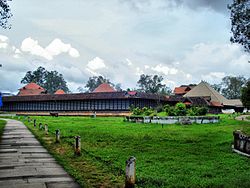Perur is a town near Coimbatore (7 KM from Coimbatore Railway Station on the Western side) near river Noyyal. This Kongu region of Tamilnadu has got one of the best known Sivasthalams in Perur. This temple dates back to the Chola dynasty, about 1500 years back, during early Christian Era. This temple was built by Palayakkars and the inner most sanctum sanatorium was built by Karikala Cholan. The main deity of the temple is Lord Patteeswarar and His consort is Parvathi also called as Pachainayaki Amman. As the legend goes that a cow Khamadhenu and its calf Patti worshipped Lord Shiva in this temple and the name Patteeswarar was born. Similar is the legend with the other two famous Siva temples - one Patteeswarar temple at Dharasuram near Kumbakonam and the other Sri Dhenupureeswarar temple in Madambakkam near Chennai.
 |
Different views of the temple entrance |
This magnificent temple's architecture is unique and beautiful. The famous hall Kanagasabhai where the Nataraja sannadhi is situated has rare, very beautifully and intricately carved priceless stone sculptures depicting different manifestations of Lord Siva and other gods on both sides that stand testimony to the splendid work of temple architecture in Tamilnadu. It's really a wonderful feast to the eyes of those who love ancient temple architecture. A gold plated Nataraja statue offering blessings two sages Goumuni and Pattimuni add more beauty to the Kanagasabai hall. This temple is called 'Mel Chidambaram'.
 |
| One of the intricately carved beautiful stone sculptures |
Some of the main and important festivals celebrated in this temple are Panguni Uthram during March, Natyanjali (festival of dance) in September, karthigai Sangabishekam in November and Arudhra darshanam in December. Thousands of devotees gather here during festivals time to offer their prayers to Lord Patteeswarar and Goddess Perianayaki to seek their blessings and bestow them with their benign grace.
This place has got some wonder specialities - the seeds of the tamarind tree in front of the temple do not germinate when sown which spells the truth that those pray to Lord Patteeswarar will attain total salvation and no births or deaths any more for them; the palm tree is praised as Irava Panai (இறவா பனை) meaning it won't fall down which symbolically mean that those belief Lord Patteeswarar never bow down but ever straight with name and fame; the bones of those dead when immersed in Noyyal river would turn to white stones; a belief is that dying creatures would keep their right ears upwards to listen to the Lord uttering 'Namashivaya' mantra to take them to Heaven; the cow dungs found around this place would have no germs.
Saints Sundrar sang in praise of Lord Patteeswarar in this temple in Thevaram when he came to visit his friend King Cheramaan Perumal who ruled Kerala at that time. But, the ten pathogams sung by Sundarar are not available.
During 18th century, when Tippu Sultan invaded south he attached some of the Inams of the temple and later it was restored back to the temple by East India Company. A treasure trove containing Roman coins were found in Perur which dates back to the Roman period.
Temple timings are - 6.00 am to 1.00 pm and 4.00 pm to 8.30 pm. Pooja timings are 7.30 am to 12.00 noon and 7.30 pm to 8.30 pm. Contact Phone No. +91 4222607991.
|
|
|
|
 |
| வணக்கம் |
|
























